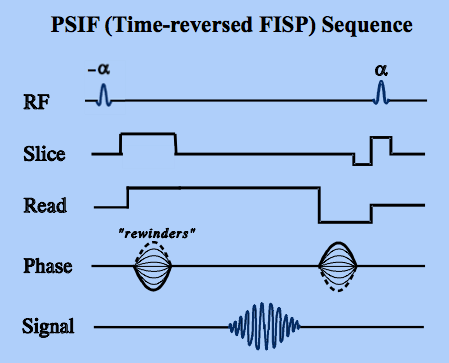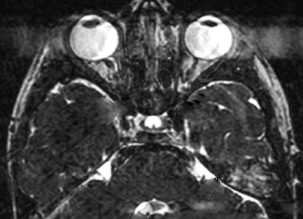|
PSIF is Siemens' acronym for a steady-state GRE sequence that samples the spin echo/stimulated echo components of the free precession signal rather than the FID. PSIF is a reversal of the letters in the acronym FISP and is appropriate because the pulse-timing diagrams for FISP and PSIF are mirror images of each other. GE and Canon call their versions of this sequence SSFP. This acronym is misleading, however, since both FISP and PSIF are steady-state free precession sequences. Philips refers to its version as T2-FFE.
|
The generation of the PSIF signal is somewhat difficult to explain because the recorded signal is actually the rephasing of an echo created by an RF-pulse in the preceding cycle. The effective echo time is thus really TR +TE, since an entire additional cycle (of length TR) has passed prior to echo collection. This creates an interesting paradox in that the stated TE for a PSIF pulse sequence is actually longer than TR!
|
This relatively large evolutionary period before echo collection allows for natural transverse decay of the magnetization to occur. Images from PSIF sequences thus appear to have a prominent T2-weighting regardless of the other parameters chosen. Because T2 contrast is apparently "enhanced" by this technique, the acronym "contrast-enhanced FAST" or CE-FAST was the original name given to this sequence.
For completeness, the signal intensity equation for the PSIF sequence is given below: |
This equation is similar in appearance to the GRASS/FISP equation given in a prior Q&A. The one notable difference is that the final term is e−TE/T2 rather than e−TE/T2*, reflecting the fact that PSIF collects the echo-like signal rather than the FID-like signal, and hence displays T2- rather than T2*-weighting.
|
PSIF sequences display high signal from fluids like CSF, and in the 1990's were sometimes used for MR-cisternography and myelography. Although CSF signal was high, image contrast of the soft tissues was poor. More fatally, however, these sequences suffered from motion artifacts as seen in the image above. I never liked these sequences and never used them.
Today PSIF sequences have been largely abandoned in favor of fast spin echo and balanced-GRE sequences, although some recent publications suggest that with modifications they may be useful for peripheral neurography, diffusion imaging, and black blood angiography. As shown in the example right, we are currently using a PSIF-based, single-direction diffusion-weighted sequence for spinal cord imaging with good results, although exact ADC values cannot be calculated. |
Advanced Discussion (show/hide)»
No supplementary material yet. Check back soon!
References
Chhabra A, Subhawong TK, Bizzell C, et al. 3T MR neurography using three-dimensional diffusion-weighted PSIF: technical issues and advantages. Skeletal Radiol 2011; 40:1355-1360.
Chavhan GB, Babyn PS, Jankharia BG et al. Steady-state MR imaging sequences: physics, classification, and clinical applications. Radiographics 2008;28:1147-1160.
Elster AD. Gradient echo imaging: techniques and acronyms. Radiology 1993; 186:1-8. (My older review; still accurate, though some vendors have gone out of business. Gives a good history of the development of GRE sequences).
Gyngell ML. The application of steady-state free precession in rapid 2DFT NMR imaging: FAST and CE-FAST sequences. Magn Reson Imaging 1988; 6:415-9.
Hänicke W, Vogel HU. An analytical solution for the SSFP signal in MRI. Magn Reson Med 2003; 49:771-775. [DOI LINK]
Chhabra A, Subhawong TK, Bizzell C, et al. 3T MR neurography using three-dimensional diffusion-weighted PSIF: technical issues and advantages. Skeletal Radiol 2011; 40:1355-1360.
Chavhan GB, Babyn PS, Jankharia BG et al. Steady-state MR imaging sequences: physics, classification, and clinical applications. Radiographics 2008;28:1147-1160.
Elster AD. Gradient echo imaging: techniques and acronyms. Radiology 1993; 186:1-8. (My older review; still accurate, though some vendors have gone out of business. Gives a good history of the development of GRE sequences).
Gyngell ML. The application of steady-state free precession in rapid 2DFT NMR imaging: FAST and CE-FAST sequences. Magn Reson Imaging 1988; 6:415-9.
Hänicke W, Vogel HU. An analytical solution for the SSFP signal in MRI. Magn Reson Med 2003; 49:771-775. [DOI LINK]
Related Questions
How do GRASS/FISP sequences work?
How do GRASS/FISP sequences work?




